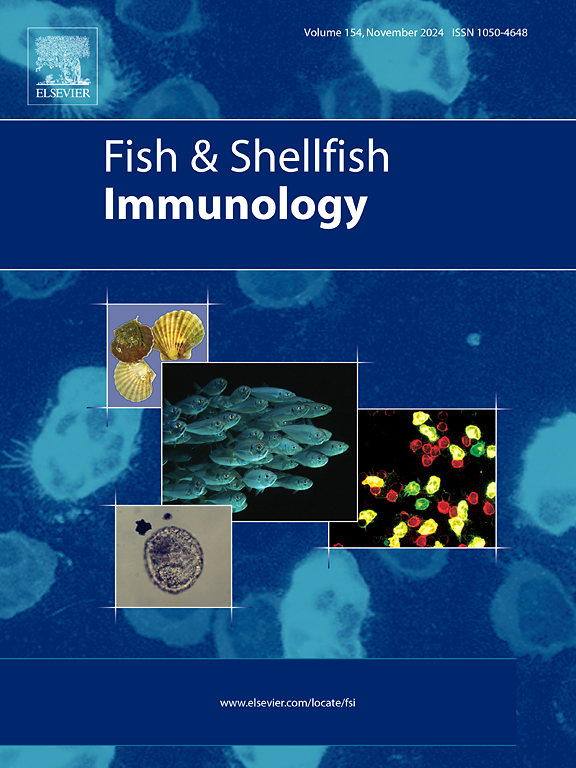作为预防鱼类天疱疮潜在疫苗的海产天疱疮外膜囊泡 (OMVs)。
IF 4.1
2区 农林科学
Q1 FISHERIES
引用次数: 0
摘要
外膜囊泡 (OMV) 能够诱导强大的保护性体液免疫和细胞介导免疫,因此在疫苗学中日益受到关注。革兰氏阴性细菌海洋tenacibaculimum是海洋tenacibaculosis的致病菌,由于其难以预防,给全球水产养殖业带来了巨大挑战。在以前的研究中,我们证明了 OMV 的产生是海洋栉水母的一个关键毒力机制。在此基础上,本研究旨在评估一种由不含佐剂的粗制海产栉水母 OMVs(Tm-OMVs)制成的天然封装多抗原疫苗的功效。使用SP9.1-OMVs对幼年大菱鲆(Scophthalmus maximus L.)进行了疫苗接种实验,随后对其进行了海产褐斑大菱鲆(T. maritimum)浸浴挑战。通过测量抗Tm抗体水平和分析八个关键免疫相关基因(il-1β、il-8、il-22、pcna、c3、cd4-1、ifng2、cd8α)的表达,评估了大菱鲆的免疫反应。结果表明,用SP9.1-OMV免疫可显著保护鱼免受T. maritimum感染(RPS = 70%)。接种疫苗的鱼血浆中的抗 Tm 抗体滴度呈剂量依赖性增加,同时先天性免疫基因(il-1β、il-8、il-22、c3)和适应性免疫基因(cd4-1、ifng2、cd8α)在浴后四小时就开始快速诱导。这些发现为了解大菱鲆感染海褐斑病后的早期免疫反应提供了新的视角,可作为开发基于 OMV 的新型疫苗的基础。本文章由计算机程序翻译,如有差异,请以英文原文为准。
Outer membrane vesicles (OMVs) from Tenacibaculum maritimum as a potential vaccine against fish tenacibaculosis
Outer membrane vesicles (OMVs) have been gained increasing attention in vaccinology due to their ability to induce strong protective humoral and cell-mediated immunity. The Gram-negative bacterium Tenacibaculum maritimum, the causative agent of marine tenacibaculosis, poses a significant challenge to the global aquaculture industry due to its difficult prophylaxis. In previous studies, we demonstrated that OMV production is a key virulence mechanism in T. maritimum. Building on this, the present study aimed to evaluate the efficacy of a natural, encapsulated multi-antigen vaccine made from adjuvant-free, crude T. maritimum OMVs (Tm-OMVs). A vaccination experiment using SP9.1-OMVs was conducted in juvenile turbot (Scophthalmus maximus L.), followed by a T. maritimum bath challenge. Immune responses in the turbot were assessed by measuring anti-Tm antibody levels and analyzing the expression of eight key immune-related genes (il-1β, il-8, il-22, pcna, c3, cd4-1, ifng2, cd8α). The results showed that immunization with SP9.1-OMVs provided significant protection against T. maritimum infection (RPS = 70 %). Vaccinated fish exhibited a dose-dependent increase in anti-Tm antibody titers in blood plasma, along with rapid induction of both innate (il-1β, il-8, il-22, c3) and adaptive (cd4-1, ifng2, cd8α) immune genes as early as 4 h post-bath challenge. These findings offer new insights into the early immune response of turbot following T. maritimum infection and could serve as a foundation for developing novel OMV-based vaccines.
求助全文
通过发布文献求助,成功后即可免费获取论文全文。
去求助
来源期刊

Fish & shellfish immunology
农林科学-海洋与淡水生物学
CiteScore
7.50
自引率
19.10%
发文量
750
审稿时长
68 days
期刊介绍:
Fish and Shellfish Immunology rapidly publishes high-quality, peer-refereed contributions in the expanding fields of fish and shellfish immunology. It presents studies on the basic mechanisms of both the specific and non-specific defense systems, the cells, tissues, and humoral factors involved, their dependence on environmental and intrinsic factors, response to pathogens, response to vaccination, and applied studies on the development of specific vaccines for use in the aquaculture industry.
 求助内容:
求助内容: 应助结果提醒方式:
应助结果提醒方式:


